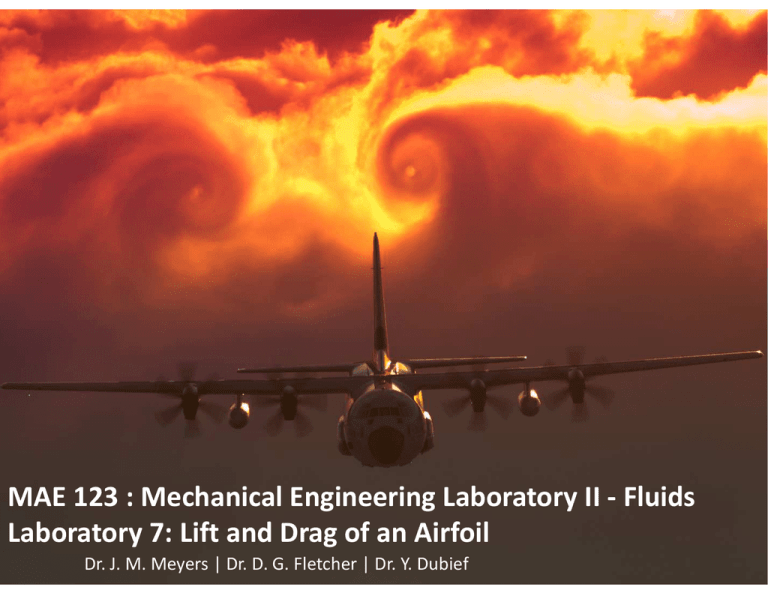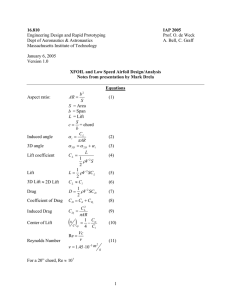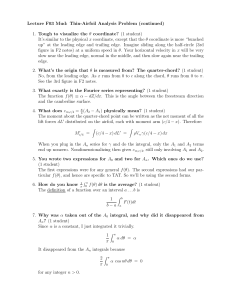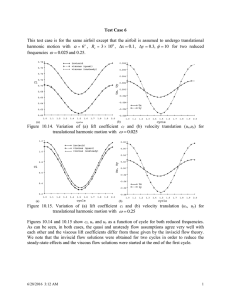ME 123 Lecture 9 Airfoil (jmm)
advertisement

MAE 123 : Mechanical Engineering Laboratory II - Fluids Laboratory 7: Lift and Drag of an Airfoil ME 123: Mechanical Engineering Lab II: Fluids Dr. J. M. Meyers | Dr. D. G. Fletcher | Dr. Y. Dubief Laboratory 7: Lift and Drag of an Airfoil Basic Forces of an Aircraft Airfoil Section Side-view shape of wing Four main forces act on an aircraft in flight: Thrust (if the aircraft is powered), Drag, Lift, and Weight We are concerned only with Lift and Drag at the moment. The main contribution to lift (and substantial drag at times) comes from the wing which has a certain airfoil shape or airfoil section (see above) Airfoils shapes are designed to provide high Lift values at low Drag for given flight conditions Conventional aircraft wings often use moving surfaces (flaps and slats) to adapt to different conditions however our study will just focus on baseline airfoil shape ME 123: Mechanical Engineering Lab II: Fluids Laboratory 7: Lift and Drag of an Airfoil 2 Flow Over an Airfoil The drawing above illustrates a common incorrect description of lift for an airfoil, which is the basic shape of an air vehicle wing or a helicopter blade. It basically states that owing to the longer flow path on the top surface, the flow reaches higher velocity, which corresponds to lower pressure (remember Venturi effect?) The pressure difference over the area of the airfoil provides a net upward force that is called Lift… this is true This is a typical shape for a subsonic airfoil - it is not symmetric but symmetric airfoils also produce lift ME 123: Mechanical Engineering Lab II: Fluids Laboratory 7: Lift and Drag of an Airfoil 3 Flow Over an Airfoil The flow over the top of a lifting airfoil does travel faster than the flow beneath the airfoil. But the flow is much faster than the speed required to have the molecules meet up at the trailing edge. In fact it is the turning of the flow that's important, not the faster flow owing to longer distance. Circulation!!!! ME 123: Mechanical Engineering Lab II: Fluids Laboratory 7: Lift and Drag of an Airfoil 4 Other Applications ME 123: Mechanical Engineering Lab II: Fluids Laboratory 7: Lift and Drag of an Airfoil 5 Terminology for Airfoils Airfoils have a leading edge and a trailing edge, and are usually designed with different top and bottom surface curvatures to promote the flow induced pressure difference that causes lift. The chord is defined as the line connecting the leading edge and the trailing edge Camber is defined as the maximum distance from the chord to either surface Chord length, , is the overall airfoil length Angle of attack, , is defined as the angle between the extended chord and the relative fluid flow direction (usually horizontal) ME 123: Mechanical Engineering Lab II: Fluids Laboratory 7: Lift and Drag of an Airfoil 6 Basic Forces on a Wing • Aerodynamic forces result from the pressure distribution over the surface • One useful way to evaluate the aerodynamic forces is to use pressure taps to record the distribution and to integrate the distribution to find the net force • For lift this integration is concerned with the pressure distribution in the vertical direction, while for drag the horizontal pressure distribution is important • You can see from the image how the surface “pushes back” with a force against the pressure, which always acts normal to the surface • Surface curvature is IMPORTANT ME 123: Mechanical Engineering Lab II: Fluids Laboratory 7: Lift and Drag of an Airfoil 7 Angle of Attack and Stall • Two mechanisms are used to generate Lift • The first is an asymmetric profile (about the chord – defined in previous slide). This is often used for subsonic flight applications. • The second is to incline the airfoil at an angle relative to horizontal, which is usually the “relative wind angle” • For low values of this angle (angle of attack) the flow remains attached on both surfaces • For higher angles of attack separation occurs that increases drag and reduces lift. • Eventually, the airfoil (and vehicle!) reaches a stall condition, where the pressure distribution on the top and bottom are equal ME 123: Mechanical Engineering Lab II: Fluids Laboratory 7: Lift and Drag of an Airfoil 8 Surface Pressure Distribution Measurement The aerodynamic performance of airfoil sections can be studied most easily by reference to the distribution of pressure over the airfoil • As we have stated, one way to evaluate the aerodynamic forces is to measure the surface pressure distribution and integrate that over the airfoil area • Taps can be placed at various locations on the surface and tubes run out the side of the airfoil to bring the pressure information to a transducer • Pressure acts normal to the surface, so the curvature must be known at the tap location, and the tap samples the pressure over a finite area surrounding the tap • The angle represents the angle between the chord normal and the surface normal at the tap • NOTE that the angle relative to the wind influences the pressure distribution ME 123: Mechanical Engineering Lab II: Fluids Laboratory 7: Lift and Drag of an Airfoil 9 Surface Pressure Distribution Measurement • The aerodynamic performance of airfoil sections can be studied most easily by reference to the distribution of pressure over the airfoil Recall that the wind tunnel has a reference pressure tap located upstream of the test section and that the pressure there is = ℎ −ℎ • From the Bernoulli relation we can find the corresponding velocity along a horizontal stream line: 2 = • ℎ −ℎ The 16 pressure taps provide pressure values determined from the manometer as: = • −ℎ The total force the pressure distribution exerts on the wing is: = • ℎ −( ∙ ) The surface normal angle, , varies with pressure tap location!!! • As the wind is traveling in the x-direction, we can decompose this force into horizontal and vertical components to recover the aerodynamic forces: Lift: = ME 123: Mechanical Engineering Lab II: Fluids Laboratory 7: Lift and Drag of an Airfoil Drag: = 10 Surface Pressure Distribution Measurement • Taking account of both the angle of the surface normal relative to the chord normal at each tap and the angle of attack, the force evaluation in the vertical direction is: = • = !− cos(% + ) As we do not have a continuous pressure distribution, we evaluate this with a numerical summation: = • = '− cos(% + ) Δ A similar expression can be derived for the Drag Force: = = '− ME 123: Mechanical Engineering Lab II: Fluids Laboratory 7: Lift and Drag of an Airfoil sin(% + ) Δ 11 Surface Pressure Distribution Measurement Pressure Coefficient To handle different wind conditions, non-dimensional (unitless!) representations are used based on the pressure coefficient: − − 1 Here we will define the / +,- = = 0 = 1 0 / dynamic pressure as: 2 2 +, is the difference between local static pressure and free-stream (at ∞) static pressure, nondimensionalized by the free-stream dynamic pressure. What does an airfoil pressure coefficient distribution look like? We generally plot +, vs. 3/5. negative pressure positive pressure +, at the airfoil stagnation point is unity. Why is this? Think of Bernoulli relation and definition of the stagnation point (67 8 = 0). It then rapidly decreases on both the upper and lower surfaces and finally recovers to a small positive value of +: near the trailing edge ME 123: Mechanical Engineering Lab II: Fluids Laboratory 7: Lift and Drag of an Airfoil 12 Surface Pressure Distribution Measurement Pressure Coefficient The upper surface pressure is lower (plotted higher on the usual scale) than the lower surface +, in this case… but it doesn't have to be. The lower surface sometimes carries a positive pressure, but at many design conditions is actually pulling the wing downward. The pressure at the trailing edge is related to the airfoil thickness and shape near the trailing edge. Large positive values of +: at the trailing edge imply more severe adverse pressure gradients. Pressure recovery region: Pressure increases from its minimum value to the value at the trailing edge. This adverse pressure gradient is associated with boundary layer transition and possibly separation, if the gradient is too severe… which occurs at higher angles of attack!!! ME 123: Mechanical Engineering Lab II: Fluids Laboratory 7: Lift and Drag of an Airfoil 13 Surface Pressure Distribution Measurement Lift and Drag Coefficients • It is common to also common to represent Lift and Drag non-dimensionally (no units!) as the Lift and Drag coefficient: +; = 0 < += = 0 < < is known as the wing planform area Wing Planform Area, > ME 123: Mechanical Engineering Lab II: Fluids Laboratory 7: Lift and Drag of an Airfoil 14 Flow Separation ME 123: Mechanical Engineering Lab II: Fluids Laboratory 7: Lift and Drag of an Airfoil 15 Surface Pressure Distribution Measurement ?@ ?@ Critical Angle of Attack ?A Reynolds number dependent +,- = − 0 +; = 0 < ME 123: Mechanical Engineering Lab II: Fluids Laboratory 7: Lift and Drag of an Airfoil += = 0 < 0 = 1 2 / 16 Surface Pressure Distribution Measurement +,- = − 0 +; = 0 < ME 123: Mechanical Engineering Lab II: Fluids Laboratory 7: Lift and Drag of an Airfoil += = 0 < 0 = 1 2 / 17 Experiment Objectives • Understand the principles of Lift and Drag on an aerodynamic surface • Acquire a pressure distribution over a body and approximate Lift and Drag • Understand the importance of pressure, lift, and drag coefficient non-dimensional parameters • Understand the behavior of flow separation • Understand how flow separation behavior leads to stall (loss of lift) ME 123: Mechanical Engineering Lab II: Fluids Laboratory 7: Lift and Drag of an Airfoil 18 Experiment Procedure • Experiment will make use of a NACA 2415 airfoil mounted into the Flowtek 1440 1’x1’ wind tunnel • Start the wind tunnel • Set the desired angle of attack and adjust the RPM to obtain the desired upstream air velocity, (consult your data from the Venturi lab) • Record the pressure readings for the 16 taps • Rotate airfoil and readjust speed. • Determine the airfoil stall angle for both positive and negative angle • Use tufts as a visual tool for stall. ME 123: Mechanical Engineering Lab II: Fluids Laboratory 7: Lift and Drag of an Airfoil 19 Experiment Results • Determine the pressure coefficient distribution over the airfoil for various air speeds and angles of attack • Determine the lift and drag coefficients for various air speeds and angles of attack • Determine Reynolds number for all flow conditions… this will be used to compare with existing experimental data ME 123: Mechanical Engineering Lab II: Fluids Laboratory 7: Lift and Drag of an Airfoil 20 Experiment Upper Surface NACA 2415 Airfoil Lower Surface Pressure Tap B (%c) C (%c) D [rad] EF [m2] Leading Edge 0 0 1 1.193 2.657 0.9006 0.002577 2 5.688 5.374 0.3688 0.003374 3 14.89 7.944 0.1838 0.004548 4 25.40 9.185 0.05831 0.00561 5 39.44 9.278 -0.03975 0.006633 6 54.25 8.155 -0.1037 0.006633 7 68.64 6.308 -0.1503 0.006785 8 84.16 3.628 -0.2111 0.01107 Trailing Edge 100 0 Pressure Tap B (%c) C (%c) D [rad] EF [m2] Leading Edge 0 0 9 1.451 -2.213 0.7282 0.002502 10 6.730 -4.301 0.2264 0.002994 11 14.11 -5.353 0.08516 0.003411 12 21.70 -5.688 0.00835 0.00474 13 35.08 -5.467 -0.03805 0.006444 14 49.93 -4.673 -0.06709 0.006595 15 63.99 -3.585 -0.08428 0.00705 16 80.72 -2.083 -0.1027 0.01251 Trailing Edge 100 0 ME 123: Mechanical Engineering Lab II: Fluids Laboratory 7: Lift and Drag of an Airfoil 21 References 1. 2. 3. J.D. Anderson, “Fundamentals of Aerodynamics”, Kuethe and Chow, “Foundations of Aerodynamics: Bases of Aerodynamic Design,” 4th edition, John Wiley and Sons, 1986 Abbott and von Doenhoff, “Theory of Wing Sections: Including a Summary of Airfoil Data,” ME 123: Mechanical Engineering Lab II: Fluids Laboratory 7: Lift and Drag of an Airfoil 22



